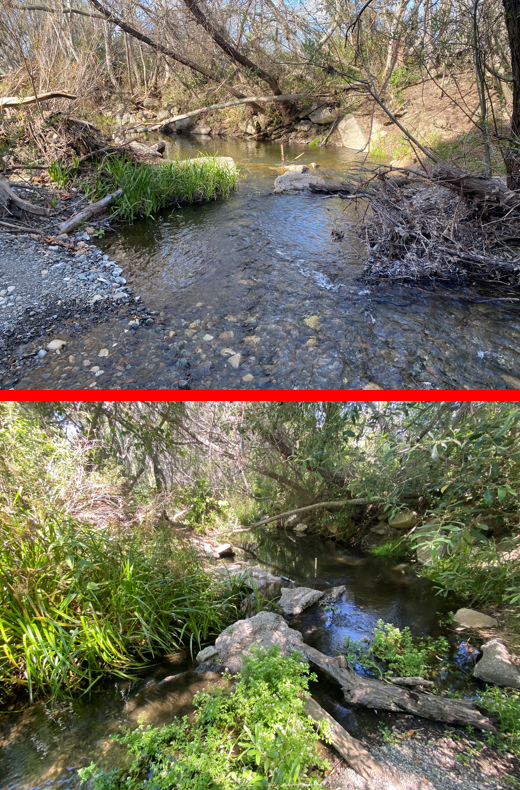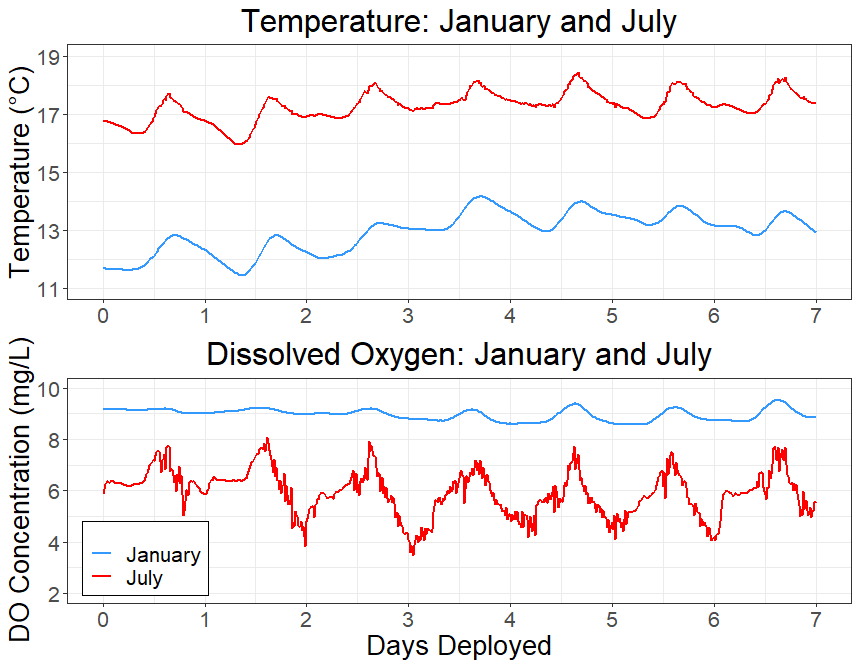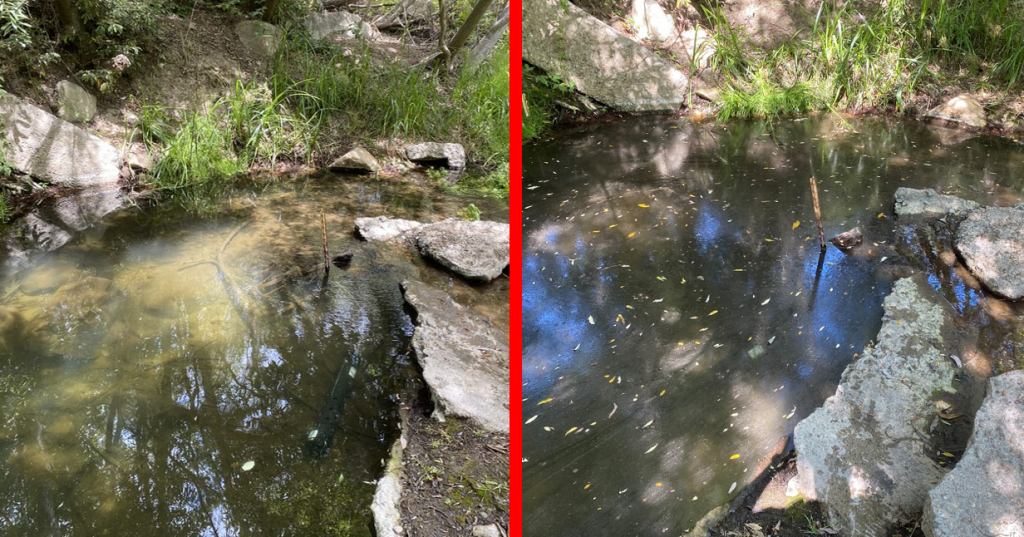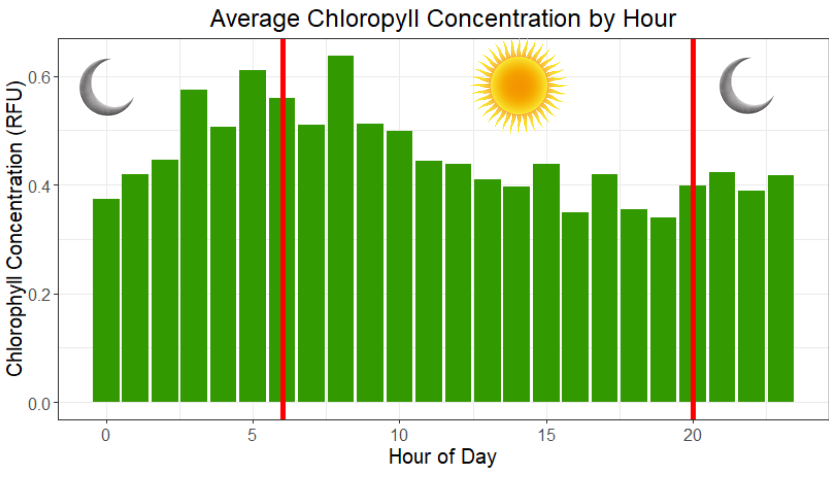Creeks Change with the Seasons
Even in a watershed with a mild Mediterranean climate, our creek systems feel the effects of the changing seasons. In winter, the water is cold and large rainfall events raise water levels, connecting smaller tributaries to larger mainstem creeks and allowing steelhead to migrate upstream. In spring, the water begins to warm up and rainfall is scattered and infrequent. Heading into the summer, water temperature continues to climb and the tributaries begin to go dry, creating small pools where juvenile steelhead hunker down until the rains return.
The More Deployments, the Merrier
The Estuary Program monitors water quality and flow year-round and has grown accustomed to the changes each season brings. The addition of the EXO3 continuous water quality sonde, introduced in a previous blog post, allows us to look at these changes in greater detail. The sonde features multiple, interchangeable sensors, that each measure a different water quality parameter.

Starting in January, the Estuary Program deployed the EXO3 sonde along several creek segments to better understand how these systems change over short time periods. A field blog from April highlights one such deployment on Dairy Creek. The Estuary Program also completed several deployments at the same site along Chorro Creek to investigate how things change over the seasons.
Comparing Data between Deployments
Some of the changes in the creeks are easily understood, such as waters warming as we move from winter to summer. Other changes require a bit more context to understand. For example, levels of oxygen (called dissolved oxygen) in the creek look very different in January than in July.

Dissolved oxygen concentrations are negatively correlated with temperature, meaning when water temperature is higher in the summer, the amount of oxygen in the water drops.
But what the deployment data does not directly explain is why the variability of dissolved oxygen is so much higher in July. While the temperatures barely fluctuated during both deployments (temperatures stayed within three degrees Celsius during both time periods), the daily change in dissolved oxygen concentration is much more dramatic in July than in January. In January, dissolved oxygen barely strayed from 9 milligrams per liter (mg/L), but in July, oxygen could drop from 8 mg/L to 4 mg/L in a matter of hours. What could cause such a dramatic shift?
Algae Drives Oxygen Availability
Water chemistry and temperature are not the only things that change with the seasons. In fact, these changes initiate responses in surrounding organisms, such as algae in the water. When the creeks warm up and water levels drop, the flow rate also decreases, creating pools of nearly-stagnant water that offer the perfect habitat for algae. Combining these conditions with increased sunlight in the summer and you have the perfect recipe for an algal bloom.

And it just so happens that algae are the key to our question regarding dissolved oxygen variability in the summer. Algae, like most plants, use photosynthesis to store energy from sunlight. Photosynthesis also converts carbon dioxide to oxygen, increasing oxygen concentrations in the water when the sun is shining. But when the sun sets, algae switch to respiration to perform their cellular functions. When in this mode, the algae convert oxygen to carbon dioxide (much like how we breathe) and creek oxygen levels decrease.
In creeks with high amounts of algae, the summertime oxygen fluctuations are unfortunately a common occurrence. These conditions are not ideal for aquatic life, as they result in lower than optimal oxygen levels and major swings in oxygen over short periods of time. This can be stressful for sensitive species like steelhead and impact their ability to thrive.
Using the EXO3 to Investigate Algae
The example above highlights the importance of monitoring algae in creek systems. The Estuary Program recently added a new algae sensor to the EXO3 sonde to measure the amount of chlorophyll, a light-sensitive pigment used by algae during photosynthesis. This sensor offers a glimpse into the behavior of algae throughout the day.

Interestingly, higher chlorophyll concentrations do not necessarily mean more algae is present. The data in the graph above shows that chlorophyll decreases throughout the day and increases at night. Chlorophyll is the pigment responsible for converting sunlight to energy, and when light availability is low, algae produce more chlorophyll to take advantage of all of the light they can. When the sun comes out and light is abundant, less chlorophyll is needed so algae drop off their production.
As the Estuary Program continues its deployments, we will further develop our understanding of these processes and how to best interpret them to protect water quality and sensitive species. Stay tuned!
Help us protect and restore the Morro Bay estuary!
- Donate to the Estuary Program today and support our work in the field, the lab, and beyond.
The Estuary Program is a 501(c)3 nonprofit. We depend on funding from grants and generous donors to continue our work. - Support us by purchasing estuary-themed gear from ESTERO. This locally owned and operated company donates 20% of proceeds from its Estuary clothing line and 100% of Estuary decal proceeds to the Estuary Program. Thank you, ESTERO!
- Purchase items from the Estuary Program’s store on Zazzle. Zazzle prints and ships your items, and the Estuary Program receives 10% of the proceeds.
Thank you for helping our beautiful, bountiful, biodiverse bay!